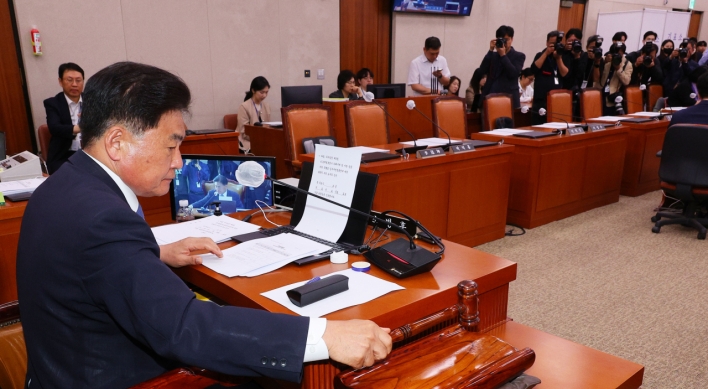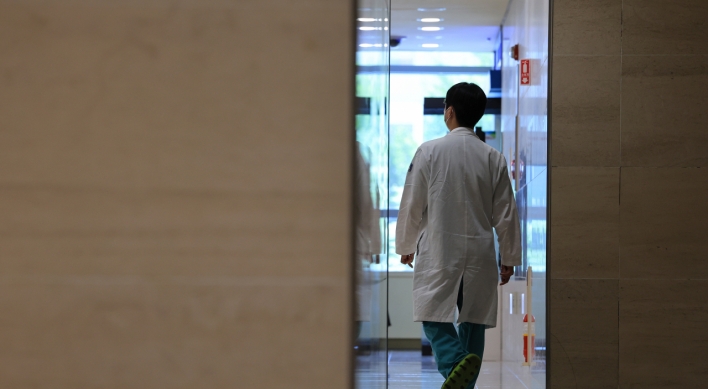[Editorial] The sooner, the safer
Swift preparations needed to prevent COVID-19 explosion in capital area
By Korea HeraldPublished : March 12, 2020 - 17:17
One hundred and two people have been found to be infected with the new coronavirus in a cluster traced to a call center in Seoul as of Thursday morning.
The number could rise, as tests are being done on people who worked on other floors of the Korea Building in Seoul’s Guro District.
The health authorities say the situation is not as grave in Seoul and adjacent Gyeonggi Province as it is in Daegu and North Gyeongsang Province. But with the slightest slip, the situation in the Seoul area could get much worse.
The infected workers live scattered over the densely populated capital region, where about half of the nation’s 51 million people reside. Many people commute across the region using crowded public transit. Enclosed office spaces abound, and small public facilities are ubiquitous. The infection cluster in the call center, if not controlled successfully, could spread at a calamitous rate.
The location of the Korea Building, where the call center rents space, is particularly concerning because of the large number of people who travel to and through it. It is situated between two bustling subway stations -- Guro Station on Subway Line No. 1 and Sindorim Station, a transfer station on subway lines 1 and 2. The stations serve as hubs linking Seoul to Incheon and numerous cities in Gyeonggi Province.
More than 25,000 people use Guro Station every day, while about 100,000 go in and out of Sindorim Station. Some 7 million people ride the Seoul subway every day. Most subway trains are crowded at rush hour, and countless buses stop near subway stations.
Most of the infected workers reportedly commuted from other districts of Seoul, or from Incheon or Gyeonggi Province, along the two subway lines and on buses.
Worse still, some are believed to have shown symptoms as early as March 3 or 4. Many passengers must have been in close proximity to them, and there is a good chance they unknowingly passed on the virus.
Considering that it is almost impossible to identify everyone who made contact with the infected workers by sharing a subway train or a bus, the incident is stoking up fear. Furthermore, in a situation in which South Korea keeps its doors partially open to China, there is no telling where or how fast the virus may be spreading in the country.
The health authorities focused intensively on large-scale infections connected to the secretive Shincheonji Church of Jesus in Daegu and a hospital in Cheongdo, North Gyeongsang Province.
Preoccupied with outbreaks in the region, the authorities took their eyes off the more populous Seoul area and took few proactive measures in anticipation of infection clusters at worksites such as call centers. It seems that the central government and Seoul City had 20/20 hindsight about the contagion risk in call centers.
Call center workers usually sit at arm’s length from one another and talk constantly over the phone. Their work environment exposes them to two major risk factors for infection -- close proximity and an abundance of respiratory droplets. Moreover, due to the nature of their job, they tend not to wear face masks.
According to Statistics Korea, about 76,000 people work in 982 call centers across the country. In Seoul, about 3,000 work in 41 call centers. The government said Wednesday that it would distribute guidelines to prevent infection clusters in high-risk facilities such as call centers.
Their release is urgent. The government ought to draw up proactive measures to encourage work from home, flexible work schedules and increased distance between workers. The Korea Centers for Disease Control and Prevention should step up their efforts to set up a system at their call center to enable their counselors to work from home.
The Financial Supervisory Service and the Korea Communications Commission launched emergency inspections of call centers affiliated with financial institutions and telecom companies. They reportedly asked the centers to space their workers further apart. Special inspections and corrective measures are needed for gyms, karaoke rooms, internet cafes and nightclubs as well.
Above all, the health authorities must carry out more tests to find infected individuals early. At the same time, together with the three local governments, they must speed up their preparations for a worst-case scenario. Before the country encounters a sudden surge of infections, the most urgent task is to secure enough negative-pressure wards for the treatment of those with serious symptoms and separate living quarters where people with mild cases can be treated in isolation. The sooner, the safer.
The number could rise, as tests are being done on people who worked on other floors of the Korea Building in Seoul’s Guro District.
The health authorities say the situation is not as grave in Seoul and adjacent Gyeonggi Province as it is in Daegu and North Gyeongsang Province. But with the slightest slip, the situation in the Seoul area could get much worse.
The infected workers live scattered over the densely populated capital region, where about half of the nation’s 51 million people reside. Many people commute across the region using crowded public transit. Enclosed office spaces abound, and small public facilities are ubiquitous. The infection cluster in the call center, if not controlled successfully, could spread at a calamitous rate.
The location of the Korea Building, where the call center rents space, is particularly concerning because of the large number of people who travel to and through it. It is situated between two bustling subway stations -- Guro Station on Subway Line No. 1 and Sindorim Station, a transfer station on subway lines 1 and 2. The stations serve as hubs linking Seoul to Incheon and numerous cities in Gyeonggi Province.
More than 25,000 people use Guro Station every day, while about 100,000 go in and out of Sindorim Station. Some 7 million people ride the Seoul subway every day. Most subway trains are crowded at rush hour, and countless buses stop near subway stations.
Most of the infected workers reportedly commuted from other districts of Seoul, or from Incheon or Gyeonggi Province, along the two subway lines and on buses.
Worse still, some are believed to have shown symptoms as early as March 3 or 4. Many passengers must have been in close proximity to them, and there is a good chance they unknowingly passed on the virus.
Considering that it is almost impossible to identify everyone who made contact with the infected workers by sharing a subway train or a bus, the incident is stoking up fear. Furthermore, in a situation in which South Korea keeps its doors partially open to China, there is no telling where or how fast the virus may be spreading in the country.
The health authorities focused intensively on large-scale infections connected to the secretive Shincheonji Church of Jesus in Daegu and a hospital in Cheongdo, North Gyeongsang Province.
Preoccupied with outbreaks in the region, the authorities took their eyes off the more populous Seoul area and took few proactive measures in anticipation of infection clusters at worksites such as call centers. It seems that the central government and Seoul City had 20/20 hindsight about the contagion risk in call centers.
Call center workers usually sit at arm’s length from one another and talk constantly over the phone. Their work environment exposes them to two major risk factors for infection -- close proximity and an abundance of respiratory droplets. Moreover, due to the nature of their job, they tend not to wear face masks.
According to Statistics Korea, about 76,000 people work in 982 call centers across the country. In Seoul, about 3,000 work in 41 call centers. The government said Wednesday that it would distribute guidelines to prevent infection clusters in high-risk facilities such as call centers.
Their release is urgent. The government ought to draw up proactive measures to encourage work from home, flexible work schedules and increased distance between workers. The Korea Centers for Disease Control and Prevention should step up their efforts to set up a system at their call center to enable their counselors to work from home.
The Financial Supervisory Service and the Korea Communications Commission launched emergency inspections of call centers affiliated with financial institutions and telecom companies. They reportedly asked the centers to space their workers further apart. Special inspections and corrective measures are needed for gyms, karaoke rooms, internet cafes and nightclubs as well.
Above all, the health authorities must carry out more tests to find infected individuals early. At the same time, together with the three local governments, they must speed up their preparations for a worst-case scenario. Before the country encounters a sudden surge of infections, the most urgent task is to secure enough negative-pressure wards for the treatment of those with serious symptoms and separate living quarters where people with mild cases can be treated in isolation. The sooner, the safer.
-
Articles by Korea Herald









![[Kim Seong-kon] Democracy and the future of South Korea](http://res.heraldm.com/phpwas/restmb_idxmake.php?idx=644&simg=/content/image/2024/04/16/20240416050802_0.jpg&u=)









![[Today’s K-pop] Zico drops snippet of collaboration with Jennie](http://res.heraldm.com/phpwas/restmb_idxmake.php?idx=642&simg=/content/image/2024/04/18/20240418050702_0.jpg&u=)